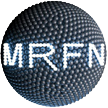The DynaPro NanoStar™ from Wyatt Technology is Dynamic Light Scattering (DLS) instrument that is used for the analysis of protein solutions, aggregates, buffers, nanoparticles, polymers, or other products in solution. In a DLS measurement, the time-dependent fluctuations in the scattered light are measured by a fast photon counter. The fluctuations are directly related to the rate of diffusion of the molecule through the solvent. Therefore, the fluctuations can be analyzed to determine a hydrodynamic radius for the sample (0,5 nm to 1000 nm).



